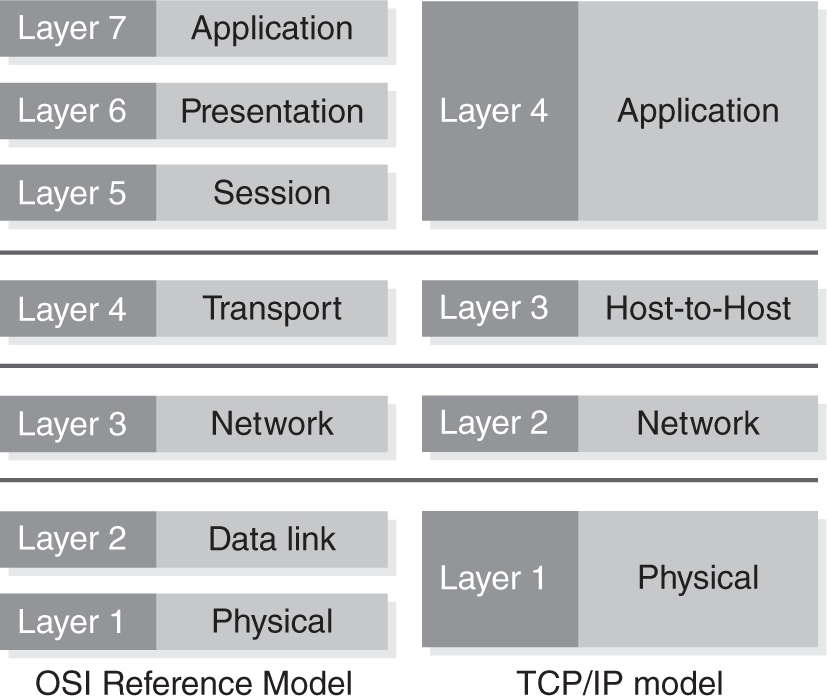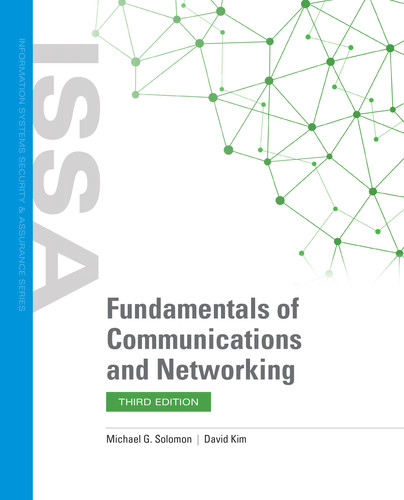TCP/IP Reference Model
An alternative to the OSI model is the Transmission Control Protocol/Internet Protocol (TCP/IP) Reference Model, which defines four layers as opposed to the seven layers in the OSI model. The TCP/IP model represents the same functionality as the OSI model, but several of the OSI layers are combined to create a streamlined model. The simplified model maps well to the backbone of Internet communications, the TCP/IP protocol suite. The biggest difference between the two models is in each model’s purpose. Although they are often used somewhat interchangeably, they address different needs. The OSI Reference Model was originally published as a prescriptive model. The OSI Reference Model provides a prescription as to how organizations should develop network software. On the other hand, the TCP/IP Reference Model was created as a descriptive model. The TCP/IP Reference Model describes how the Internet Protocol suite operates. Because the two models are commonly used to describe networks, it’s helpful to compare how the layers in the two models relate. FIGURE 3-3 shows how each of the layers in the TCP/IP model maps to the corresponding layer in the OSI model.

FIGURE 3-3 A comparison of the TCP/IP and OSI models.
Like the OSI Reference Model, the TCP/IP Reference Model is composed of multiple layers. Each of the four TCP/IP Reference Model layers is responsible for a different phase of communication. At each layer in the network stack, the layer logically communicates with the corresponding layer on the other node. The following list provides a summary of each of the TCP/IP Reference Model layers:
- Application Layer—The Application Layer is at the top of the TCP/IP Reference Model, which maps to OSI Layers 5, 6, and 7. The Application Layer interacts with applications that need to gain access to network services.
- Transport or Host-to-Host Layer—The Transport or Host-to-Host Layer provides end-to-end delivery, which maps to OSI Layer 4 (also called the Transport Layer). This layer segments the data and adds a checksum to properly validate data to ensure that it has not been corrupted.
- Network or Internet Layer—The next layer is the Network or Internet Layer, which handles the routing of packets as they move around the network. It maps to Layer 3 (also called the Network Layer) of the OSI model.
- Physical or Network Access Layer—The Physical Layer resides at the lowest layer of the TCP/IP model and is the point at which the higher-layer protocols interface with the network transport media. When compared to the OSI model, this layer corresponds to OSI Layer 1 and Layer 2.
Application Layer
The TCP/IP Reference Model Application Layer corresponds to three layers in the OSI model: the Application Layer, the Presentation Layer, and the Session Layer. It is the highest layer in the TCP/IP model and includes most of the high-level protocols application software uses for network communication. Common TCP/IP Application Layer protocols include:
- Dynamic Host Configuration Protocol (DHCP)
- Hypertext Transfer Protocol (HTTP)
- Internet Message Access Protocol (IMAP)
- File Transfer Protocol (FTP)
- Post Office Protocol (POP)
- Session Initiation Protocol (SIP)
The TCP/IP model does not define any layers between the Application Layer and the Transport Layer. The Application Layer generally handles tasks that the Session or Presentation layers would normally handle in the OSI model; for example, encryption may occur in the TCP/IP Model Application Layer. Most OSI Session and Presentation Layer functions are provided as network library calls from the application software.
Application Layer protocols are the most visible protocols in Internet applications. Many other protocols that don’t reside in the Application Layer are crucial to the network communication process. These lower-layer protocols are generally hidden from view and accessed as calls from within the operating system’s network stack. Application Layer protocols aren’t generally concerned with many of the specific details of how messages arrive at their destination. The lower-layer protocols handle the details. All the Application Layer protocols must do is pass a message to the lower-layer protocols, along with the destination’s address.
Transport Layer
The TCP/IP Reference Model Transport Layer corresponds to the Transport layer in the OSI model. These layers in different reference models accomplish nearly the same tasks. These protocols are responsible for handling end-to-end message delivery. That means the Transport Layer takes care of all the details of ensuring that a message makes it to the destination, regardless of the lower-layer protocols or networks in use. These responsibilities include ensuring that:
- Data arrives in the same state in which it was sent (error correction).
- Missing data is retransmitted.
- Data is presented to the Application Layer in the correct order.
- Duplicate data is dropped.
- Network path problems (congestion or failed links) are handled.
The most common TCP/IP Transport Layer protocols are:
- Transmission Control Protocol (TCP)
- User Datagram Protocol (UDP)
Application and Transport Layer protocols generally connect to remote nodes using specific ports to communicate. Using different ports for different protocols helps to keep individual connections separate from one another. To make communicating as easy as possible, the most popular protocols use well-known default port numbers. The Internet Assigned Numbers Authority (IANA) maintains a list of common Application and Transport Layer protocols and their default ports. Most of today’s network software adheres to the commonly agreed upon ports list. Agreeing on default port usage helps to make it easy for applications to communicate with one another.
Internet Layer
The TCP/IP Reference Model Internet Layer corresponds to the Network Layer in the OSI model. This layer is responsible for sending packets across different networks. The Internet Layer examines each packet, determines its destination, and makes the necessary routing decisions to get the packet to its destination. The Internet Layer is primarily made up of the Internet Protocol and other protocols that support IP. Some of the other supporting protocols include the Internet Control Message Protocol (ICMP) and Internet Protocol Security (IPSec).
The Internet Layer provides transparency to the upper layer protocols. Any upper layer protocol can send a message to another host without being concerned with any of the details of a specific network. IP provides this level of transparency and makes large-scale network applications possible.
Network Access Layer
The TCP/IP Reference Model Network Access Layer corresponds to the Data Link and Physical Layers in the OSI model. Network Access Layer protocols ensure packets move between nodes within the same LAN. The Internet Layer handles packets as they leave the LAN. The scope of the Network Access Layer is the current LAN. This lowest layer in the TCP/IP model is the only layer that interacts with the physical hardware. The Network Access Layer takes packets from the Internet Layer and places them on the physical media for transmission to the next node. Network Access Layer devices use switching to direct packets. Common TCP/IP Network Access Layer protocols include:
- Address Resolution Protocol (ARP)
- Layer 2 Tunneling Protocol (L2TP)
- Point-to-Point Protocol (PPP)
- Media Access Control (Ethernet, Digital Subscriber Line [DSL], Fiber Distributed Data Interface (FDDI), and so on)
The TCP/IP Reference Model describes how IP-based networks operate. Although the majority of IP-based networks also use TCP, the model supports other Transport Layer protocols. Most Internet applications follow the TCP/IP model fairly closely.
Reference models provide a common vision of how networking works. Students, manufacturers, and network professionals all use the OSI and TCP/IP reference models to understand and implement network components. In the remainder of the chapter you will learn about how specific network features work. When talking about networks, it is common to refer to one or more layers in the networking stack. Now you know what those layers mean.
